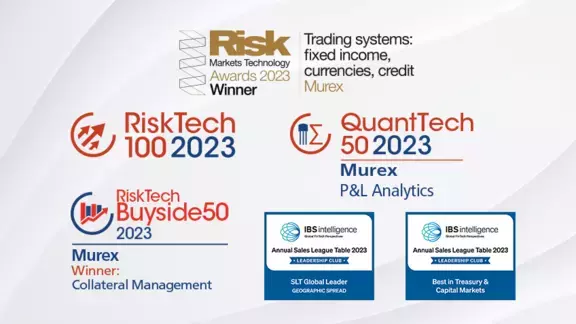-
Our solutions
- Our clients

With 300 clients and 60,000 users spread across 60 countries around the world, Murex has a truly international client base of capital markets participants.
view all case studies- Insights
- Who we are

Our awards highlight a strong level of customer satisfaction and acknowledge our market expertise.
Visit our awards webpage- Our partners
- Careers
Shaping the Future Market
Sabine Farhat of Murex explains how the changing landscape and increasing regulatory burden in the securities finance industry has put pressure on bank's technology.
Have you observed a converging of traditional silo business units within securities finance? And what other key trends are you seeing?
From a business perspective, convergence has fast become a dominant trend in the securities finance space. Over the past few years, we have witnessed the merging of securities finance with collateral and funding management for central desks. Today, we are seeing a new kind of convergence between business lines. Traditionally managed in silos, fixed income and equities are now being brought together, giving traders access to a wider range of assets and different financing tools. Moreover, in an era of increasing regulation and collateral scarcity, we observe a growing demand for more unusual assets for collateral and return swaps, which could explain the convergence of both business lines. Facilitating optimisation and collateral arbitrage, the centralised, bank-wide monitoring of assets in a single view, from collateral to equities and fixed income, with pre-packaged solutions, is also part of this new wave of convergence.
From a technology perspective, banks choosing to consolidate their securities finance activities in a single IT platform gain a significant advantage. They can centralise their data, which gives them a reliable and straight-forward way to monitor their activities. At the same time, they cannot compromise on comprehensive coverage across business lines, and technology solutions need to give them the flexibility to grow.
As the industry emerges from a period of stagnation, volumes are rising, and new synthetic products, such as listed total return futures, total return swaps on loans, bond indices and exotic bonds, are being requested more and more. We have observed an expansion in market neutral strategies as well, where there is demand for fully hedged trades and increasing volumes, and we expect this to continue. In this context, having a system that can handle stock loan/repo, return swaps, equities/ fixed income, loans and foreign exchange swaps, accurate risk and cost monitoring/transfer, with in-built connectivity to market infrastructure facilities, becomes very attractive.
How does the changing landscape and increasing regulatory burden put pressure on bank’s technology?
The need to centralise data because of increasing regulatory requirements, the rise in volumes and the larger variety of financing tools are putting pressure on technology teams to handle the growing range of products holistically, process data more quickly and safeguard data consistency. If an institution has a patchwork of different systems and modules, this is a difficult task to achieve.
Looking more closely at the regulatory environment, the Securities Finance Transaction Regulation (SFTR) will significantly impact booking models and lifecycle management. Open systems that can manage different types and standards of booking, plus trade lifecycles, will make it easier for financial institutions to maintain profitability. At the same time, it is important to invest in a system that will help you be a responsible reporter with your existing counterparties, with minimal change to your existing processes.
SFTR also increases the complexity of reporting itself as you are not simply booking the trade and then reporting it, as is the case for the European Market Infrastructure Regulation (EMIR). Under SFTR, you need global data to be able to calculate, estimate, and post required information, such as total bank assets to estimate collateral reuse. Single platforms and solutions that enable the centralisation of securities finance, collateral, equity and fixed income activities are well positioned to help financial institutions on the road to compliance.
What should firms be doing to prepare for the implementation of SFTR?
To prepare for SFTR, financial institutions need to ask themselves where data is located within their organisation. In the market today, it is more common for data to be siloed off in different parts of the business than consolidated in one place that can be easily accessed. The challenge is putting in place an internal structure that closes the gaps between the front, middle and back office. They also need to carefully reflect on the quality of their data and identify exactly how and where the regulation will impact trading with their counterpart, and if they need to change their business model to reduce potential breaks.
Financial institutions now need to start looking for technology partners that truly understand physical financing, collateral utilisation, closed and openended trades, collateral allocations, inventories and settlements. Moreover, they need software solutions that bring together each of these elements, providing a frontto-back view of their business, with native connectivity to trade repositories and reporting hubs.
Do you think the industry will need to join forces and create the best practice? Is collaboration the way forward?
In a time of significant change, both from a technology and a financial perspective, the industry needs to come together to develop, maintain and enhance market best practices. For European banks, it is vital to make sure a certain level of standardisation is met to be a responsible reporter at minimal cost and avoid losing market share to competitors who are subject to less constraining regulations.
The initiatives of associations like the International Securities Lending Association and the International Capital Market Association bring the industry together, including technology vendors, to examine the data specifications of SFTR and analyse the potential impact on financial institutions. This helps to build a consistent approach to this challenging regulation and helps shape the capital markets of the future, an important step towards standardisation.
How does Murex meet the securities finance needs of clients in an evolving market?
Murex’s MX.3 platform provides comprehensive coverage across all business lines, with solutions for trading and analytics, post-trade and risk management. This positioning naturally consolidates data and has meant we have been able to meet many of the regulatory needs of the market and evolve to new requirements easily.
Looking specifically at securities finance, the ability to adapt to the needs of our global client base meant we already had flexible booking models and could easily enrich data with new fields. For example, we already provide clients from Asia to Latin America with the capability to book repos and stock loans in the correct way for their geography.
MX.3 for securities finance covers all repos, securities lending and synthetic finance products and supports a wide range of underlying and exposure types. The single platform enables centralised management of securities and cash inventories for trading and margining with enhanced exposure management. Murex has also developed the ability to transfer positions and cost between business units. Moreover, with native connectivity to major market facilities, the solution is SFTR-ready to ensure MX.3 users can meet the requirements of regulators.
First published on SFTR Annual 2018
To learn more about MX.3 for Securities Finance, please download the flyer.
You might be interested in ...
- Our clients


